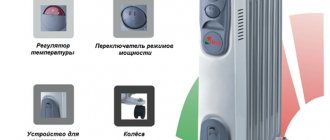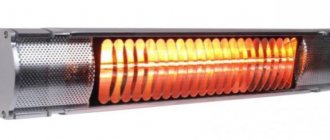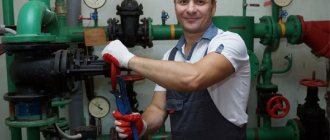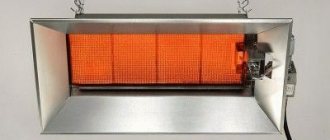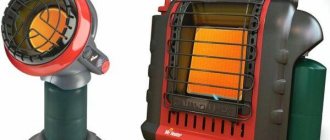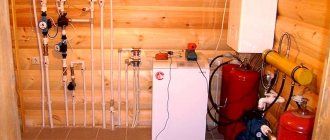In the autumn-winter period, many workshops, warehouses, greenhouses, livestock buildings, and especially our homes need heating and maintaining the temperature at an appropriate level.
Some of the most commonly used devices for this are:
- gas outdoor heaters;
- infrared heaters;
- air heaters;
- electric convectors;
- water heaters.
Air temperature is one of the most important factors determining the indoor microclimate. This is a key element of thermal comfort, which has a tremendous impact on the quality of production processes and the safety of product storage.
Heater or fan heater? When choosing equipment, first of all, you should decide where it will be used. Before purchasing, you need to familiarize yourself with their advantages and capabilities. Only then will the choice be fully conscious and satisfy your needs.
Heaters
Outdoor gas heater
The most wonderful moments in the garden or on the terrace with family and friends do not have to end with the arrival of cold evenings. The heater will provide you with a comfortable temperature, and thanks to the flame that illuminates you and the environment, it will create a unique atmosphere. The device can operate at full power without using electricity.
Infrared heater
The device provides heat to the room using low-frequency waves. Infrared radiation passes through the air and heats objects, floors, walls, which, in turn, heats the air. It does not burn oxygen and does not dry out the skin. Infrared heating type is considered the most effective and economical.
Electric convector
Convection heaters have become very popular recently. Its design includes a heating element that releases heat through the process of convection. Cold air from the room comes from below, heats up as it passes through the heat exchanger, and the already warm air rises up.
Rating of the best convector heaters of 2021
Neoclima Fast 1500 w
The stylish and functional heater is equipped with three power levels - 850, 650 and 1500 W. Quickly and effectively creates in a room up to 20 square meters. m. comfortable microclimate. Stable feet are provided for floor installation. Using the handles on the sides, it can be moved safely and easily to the desired area.
A mechanical thermostat allows you to adjust the desired heating level. temperature. Safety in operation is ensured by an overheating protection system
Pros:
- economical energy consumption;
- frost protection function;
- stable design;
- affordable price.
Minuses:
- there is no temperature scale on the thermostat;
- There is no possibility of wall mounting.
Galaxy GL8227
The convector has high heat transfer and evenly fills a room of up to 17 square meters with heat. m. The thin, stylish body allows installation anywhere in the room. There is a stand with wheels and a wall mount. Equipped with a thermostat and simple mechanical controls. Durability in operation is ensured by an overheating protection system and an anti-freeze function. Settings are adjusted on the side panel of the case.
Pros:
- stylish design;
- power and temperature adjustment;
- anti-freeze function;
- wall and floor installation;
- good quality power cable.
Minuses:
- flimsy heating control knobs;
- some elements of the body are made sloppily.
Electrolux ECH/B-1000 E
The convector is assembled in a black housing and is designed to heat an area of up to 15 square meters. m. The maximum power consumption is 1000 W. It is possible to use the 500 W mode. Electronic control allows you to set the desired air temperature in the room. The device is equipped with parental control and anti-freeze functions. The convector housing is protected from mechanical impact from sharp and heavy objects and water splashes.
Pros:
- convenient electronic control;
- presence of a timer;
- shockproof panel coating;
- quickly heats the room;
- not afraid of humidity.
Minuses:
- display backlight is too bright;
- short cord.
Fan heaters
Water fan heater
The water fan heater is ideal for heating large premises - workshops, warehouses, shops or production halls. It will quickly and effectively create thermal comfort. The design of each fan heater includes 4 main elements:
- fan;
- heat exchanger;
- frame;
- guide frame.
The heat exchanger is heated by the supply of hot water and transfers heat to the incoming air. Already heated, it is distributed throughout the room.
Advantages
- affordable price;
- multifunctionality;
- heating rate;
- easy operation.
Today, a water fan heater is the most popular and in demand equipment for heating industrial premises. By using water in the heating system, heating costs are reduced, which has a positive effect on the cost of equipment.
Fan heater or infrared?
IR heaters have different designs, quickly and silently warm up the desired area of the room and the person. They do not create air flow movements. When choosing a device, you should choose models with an improved security system.
Inexpensive, mobile, often multifunctional fan heaters quickly distribute heat throughout the room. But they dry out the air and raise dust.
Conclusion:
- When quiet operation is important and discomfort is felt from air movement, it is better to purchase an IR heater.
- If noise does not bother you, you can opt for a fan heater.
So what should you choose - a fan heater or a heater?
Industrial use
Proper room ventilation is of paramount importance not only for the health and comfort of employees, but also for the microclimate of the work area. This is especially true in places with insufficient air exchange, due to the absence or small number of windows. For example, in open offices with a large number of employees in one room, shopping centers, warehouses, agricultural greenhouses, production workshops, auto repair shops, and laboratories. In such cases, powerful water fan heaters designed for industrial facilities are installed.
The industrial use of heaters is much wider than that of fan heaters. They are often used to dry out new buildings, on large surfaces where it is impossible to install a heating system.
The use of heaters in industry helps to provide heat in logistics centers, production workshops, warehouses, commercial and industrial premises. Industrial heaters are durable due to their metal casing. The durability of the equipment guarantees many years of service and ensures reliable and continuous operation of the system, in accordance with the needs of the user.
Home use
Small, home fan heaters are an excellent choice for people who want to raise the air temperature only in their room or in a specific area. A fan will be an excellent solution to this problem. It can not only complement the central heating system, but also become the main source of heat in the cool season.
The design of home heat fans can be quite modern, minimalist and very elegant. Heaters are often more expensive, but are more effective at heating living spaces. However, a lot depends on the size of the room you want to heat.
If you want to warm up a small room, there is no point in buying a heater - an inexpensive heater will suffice.
Recommendations for choosing a heater type
So, for stationary heating of a room, you can safely choose an electric fireplace or a heat gun as the main heat source of a private building.
It is first necessary to carry out all calculations of the power and area of the room. All other models are suitable as a source of additional heat or a means for emergency spot heating of certain areas.
A thermal curtain is suitable for equipping the entrance to a country mansion if its residents actively move from the street to the house or vice versa.
As sources of additional heat in case of a centralized network failure or insufficiently high temperature in the home, we recommend purchasing convenient oil mobile radiators, convectors or safe infrared and macothermal systems.
In case of prompt injection of warm air in different rooms, we recommend purchasing a portable fan heater.
Let's sum it up
By purchasing a heater, you get:
- uniform heat distribution in the room
- no noise from the device
- possibility of heating a certain area of the room
But be prepared for the fact that it is unprofitable to use heaters in empty and large rooms, since these devices require considerable time to uniformly heat even a small area.
By choosing a fan heater, you gain the following features:
- high room heating rate
- long operating time
- fast heating function for large industrial premises
- affordable cost of the heating device
Please note that due to the powerful air flow.
created by the fan heater. The device is not recommended for use in rooms where there may be people who are allergic to dust and other small particles. It is not easy to choose between these devices and the functions that distinguish them.
It all depends on your preferences and goals. But we hope that we have successfully helped you understand this topic. If you still have questions, you can call our consultants and get all the missing information.
Table of popular models
Below we have collected several popular models of fan heaters and oil coolers from different brands. This table will help you at least roughly decide which option is most suitable.
| Fan heater | Oil heater | ||||||
| Model | Area sq. m | Cost m2 | Cost RUR | Model | Area sq. m | Cost m2 | Cost RUR |
| 20 | 39 | 780 | Oil radiator Ballu Level BOH/LV-09 2 kW | 25 | 129 | 3230 | |
| VITEK VT-2052 1.5 kW | 20 | 139 | 2790 | Timberk TOR 31.2912 QT 2.9 kW | 29 | 195 | 5656 |
| Zanussi ZFH/C-408 1.5 kW | 20 | 92 | 1850 | Electrolux EOH/M-5157N 1.5 kW | 20 | 174 | 3490 |
| Electrolux EFH/C-5125 Prime 1.5 kW | 20 | 79 | 1590 | General Climate NY12LA 1.2 kW | 12 | 286 | 3440 |
| Timberk TFH T15XCZ 1.5 kW | 20 | 125 | 2500 | Timberk TOR 51.2009 BTQ 2 kW | 25 | 176 | 4409 |
It is also worth noting that today fan heaters or oil heaters are not the most economical heating methods. They are inferior, for example, to micathermic heaters, but, nevertheless, remain the most affordable means of producing heat at home.
To complete the picture, below are several reviews from a popular forum about the use of fan heaters.
Good choice!
Oh, we almost forgot... For what purpose are you looking for a heating device?
Features of oil heaters
The classic way to provide additional heating to a house or apartment is an oil radiator, which has a simple design that includes:
- heating element, which performs the function of a heating element;
- sealed housing filled with oil.
Operating principle of the device:
- The heating element converts electrical energy into heat, which is transferred to the oil, and then to the radiator fins and the surrounding air.
- The warm air flow moves upward, and the cooled air descends and heats up again.
Advantages of oil heaters:
- Reliability.
- Quiet operation.
- Environmentally friendly.
- The presence of an intensive heating regulator.
- The presence of a timer provides the ability to select a convenient operating mode.
- Retains heat for a long time.
- Safety.
- Small overall dimensions.
- Mobility.
Minuses
The disadvantages of the device include:
- slow air heating;
- quite high price, for example, in comparison with a fan heater;
- The radiator is quite heavy.
We advise you to study the Main chemical sources of electricity
Useful tips
When choosing a device, pay attention to the following additional features:
- If a fan is built into the radiator, the room will warm up faster, since the built-in fan will disperse the air around the room.
- An air humidifier can also be built into the device model, so you don’t have to place water containers next to the heater to maintain the required air humidity.
Conclusions: which is better - a fan heater or an oil heater?
To answer the question: which is better - a fan heater or an oil heater, it is necessary to take into account the area of the room, the period of use and purpose of the room, as well as financial possibilities.
An oil radiator is convenient to use in rooms where noise is undesirable and high safety is required. This could be a children's room or bedroom. Also purchase an oil cooler if you need to maintain high temperatures, such as near your desk.
However:
- Do not use the radiator in the bathroom or other damp areas.
- An oil radiator cannot be used to dry clothes, as the inability of air to rise can cause the device to overheat.
- The radiator must always be in a vertical position, since the heating element is located at the bottom and is designed for a certain oil pressure and quantity.
- The oil device cannot be used in small rooms (area less than 4x2 m).
- Due to the high surface temperature, the oil radiator should not be placed near furniture and fusible materials (recommended distance of at least 50 cm).
Duika heater: the most economical option
Do you want to know which heater is the most economical among all the possible options? This is a fan heater. It is not only the most affordable among consumers, but also simple.
We advise you to study the Electrical Safety Program: Group 2
In addition, the heater is compact when compared with other models of radiators and convectors. The blower can be installed not only on the floor, but also on a table or mounted on a wall.
With the heating element everything is simple. In this device, the air is heated using an electric coil, which heats up, and the supply of warm air is carried out by a built-in fan, which rotates to ensure a uniform supply of air.
The main disadvantages of this device include:
- Loud noise at maximum speed;
- Possible occurrence of an unpleasant odor if there is dust on the coil;
- Increased oxygen consumption during prolonged operation.
At the moment, manufacturers have improved models of heat fans and therefore the harm that the above disadvantages can cause is minimal.
As for the care of the device, it consists of timely removal of dust and disconnecting the device from electricity. In addition, it is necessary to ensure that no water gets on the device, especially with regard to the heating coil.
